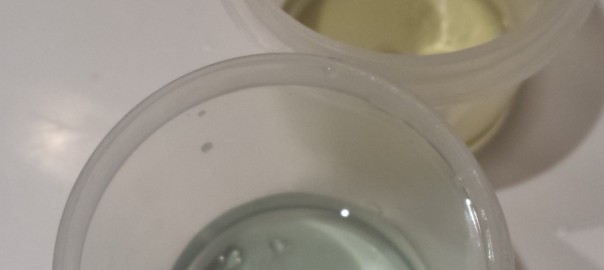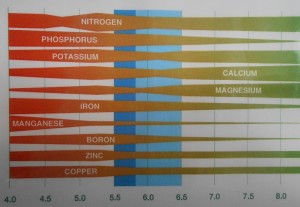pH
pH can be measured with colour changing papers or liquids, or by electronic meters.
pH is important because it effects nutrient absorption. Here’s a graph showing availability of nutrients in hydroponic applications at different pH levels (width of band represents availability).
Ideal target range for most plants is generally considered to be 5.5-5.8, but 5.5-6.5 is acceptable.
Some concepts:
pH drift: The natural change in nutrient solution pH as plants selectively absorb some elements from the solution and leave others behind.
lockout: When a nutrient is present but a plant has deficiencies because the pH of the solution doesn’t allow the nutrient’s absorption.
buffering: A buffer is a chemical which will react with the solution at certain pH levels. A good nutrient solution will be buffered, meaning that it contains some buffering agents that help it self-correct its day-to-day pH levels.
Calibrating pH
Hydro stores sell ‘pH down’ and ‘pH up’, which are food grade, non-phytotoxic acids and bases, respetively, for altering a solution’s pH.
Trivia: pH down is often phosphoric acid (H3PO4), since phosphorous is a desirable nutrient for plants.
Tapwater is generally basic and pH in hydro systems usually drifts up, so pH down is more useful than pH up. Nutrients will change pH, so correct pH after doing everything else. If my tapwater in Montreal has a pH of 8, it might be 7 after adding nutrients and I will add pH down to achieve 6.
Food safe pH changers for improvising:
Raising pH: baking soda
Lowering pH: lemon juice, vinegar
These are generally not as stable as pH up and pH down from the hydro store so check pH frequently. In the long run, It’s worth buying pH up or down if you need them frequently.
EC/TDS
EC: Electroconductivity
TDS: Total dissolved solids
These measure the same thing, but on different scales. Different plant types need different strengths, and they also drink the nutrients and water disproportionately according to environmental factors, the stage of life they’re in, etc. EC/TDS are important if you want to be able to take an existing nutrient solution and top it up. That said, if you are working on a small scale and doing a full change once in a while, things won’t get too out of control.



Are you sure pH,eC,CF in your hydroponic plant is best for your plants ? check them out with android app here https://play.google.com/store/apps/details?id=com.jpt.hydroponicrequirement